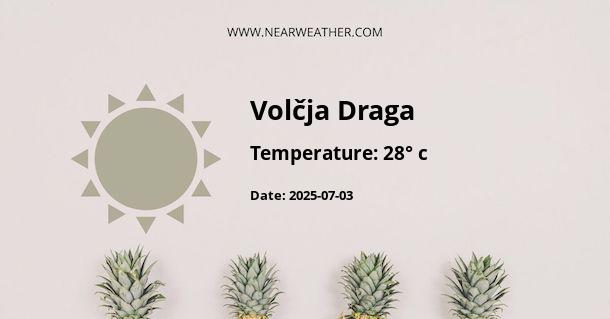Understanding Volcja Draga's Distinct Climate and Weather Patterns
The climate in Volcja Draga, a picturesque locale situated in the west of Slovenia near the Italian border, is defined by its position in the Vipava Valley. This area is known for unique weather conditions influenced by a mix of Mediterranean, Continental, and Alpine climates. To comprehend Volcja Draga's climate and its seasonal variations, a detailed examination of temperature patterns, precipitation levels, and special weather phenomena is necessary, backed by meteorological statistics and expert insights.
Temperature Trends Throughout the Year
Volcja Draga experiences a range of temperatures that vary with the changing seasons. The region's temperate climate is predominantly influenced by the warm air from the Mediterranean, leading to generally mild winters and warm summers. To better illustrate the temperature trends, it is essential to look at the average high and low temperatures throughout the year.
| Month | Average High (°C) | Average Low (°C) |
|---|---|---|
| January | 6 | -1 |
| February | 9 | 0 |
| March | 13 | 3 |
| April | 17 | 7 |
| May | 22 | 12 |
| June | 25 | 15 |
| July | 28 | 18 |
| August | 28 | 18 |
| September | 24 | 15 |
| October | 19 | 10 |
| November | 13 | 5 |
| December | 7 | 1 |
These temperatures create a conducive atmosphere for a variety of activities and agricultural practices throughout different times of the year. It is notable that the transitional seasons of spring and autumn present ideal conditions for outdoor pursuits such as hiking and cycling in the surrounding scenic landscapes.
Precipitation and Weather Patterns
Volcja Draga receives a varied amount of rainfall distributed across the year. The region is subject to both Mediterranean influences, which bring moist air leading to higher precipitation in the colder months, and Continental influences, which can lead to heavy downpours during summer months. The meticulous recording of rainfall data over the years has provided a clear view of the monthly precipitation patterns.
| Month | Average Precipitation (mm) | Rainy Days |
|---|---|---|
| January | 70 | 11 |
| February | 65 | 10 |
| March | 85 | 12 |
| April | 95 | 13 |
| May | 95 | 13 |
| June | 105 | 14 |
| July | 70 | 10 |
| August | 100 | 11 |
| September | 135 | 12 |
| October | 130 | 13 |
| November | 120 | 14 |
| December | 90 | 11 |
This information is of paramount importance for agricultural planning, tourism, and infrastructure maintenance. For example, the high rainfall in the autumn months can impact the harvest schedule and necessitate the preparation for potential flooding.
Special Weather Considerations in Volcja Draga
One of the distinguishing features of the local climate is the Bora wind. This katabatic wind is noted for its intensity and the dramatic influence it can have on daily life. It is particularly prevalent in the winter months. The Bora wind is a dry, cold wind descending from the high Karst Plateau down to the Gulf of Trieste, reaching Volcja Draga with gusts that can exceed 100 km/h.
"The Bora wind is not just a meteorological occurrence, but a defining element of the Vipava Valley's identity, shaping both the natural environment and the culture of the region." - Local Climatology Expert.
Additionally, Volcja Draga may experience occasional foggy conditions, especially in the transitional periods between seasons when temperature fluctuations are more pronounced. This fog can be dense in the valley and may affect transportation and visibility significantly.
Climate Change Impacts on Volcja Draga
Like many regions globally, Volcja Draga is not exempt from the impacts of climate change. Rising temperatures and alteration of precipitation patterns have been noted by local meteorologists and climatologists. There is a trend toward warmer temperatures, which leads to changes in agricultural practices, as certain crops become more viable while others become less so. Similarly, changes in precipitation patterns can lead to water scarcity issues during the summer months, prompting a shift in water management strategies.
- Extended periods of drought have been recorded, necessitating improved water conservation measures.
- More intense and less predictable Bora winds have implications for buildings and infrastructure.
- Variations in the start and length of seasons impact tourism and traditional festivities.
Through careful monitoring and adaptation, the residents of Volcja Draga continue to thrive in this dynamic climatic environment. Research into sustainable practices and infrastructure resilience is being conducted to ensure that the region can cope with the challenges posed by climate change.
Climatic Attractiveness of Volcja Draga
The climate in Volcja Draga, with its mild winters and warm, not excessively hot, summers, coupled with the cultural and natural richness of the area, makes it an attractive destination for tourists and residents alike. The area's viticulture is renowned, as the local climate allows for the cultivation of both traditional and unique grape varieties. Outdoor enthusiasts appreciate the weather that is conducive to exploring the natural beauty of the Vipava Valley year-round.
In conclusion, Volcja Draga’s weather and climate patterns are intricate and rich with variability, shaped by a combination of Mediterranean, Continental, and Alpine influences. Understanding these patterns is crucial for the local agriculture, infrastructure, and lifestyle, and will be increasingly important as the effects of climate change become more pronounced. The region’s resilience and adaptability, alongside its climatic appeal, continue to maintain Volcja Draga’s position as a vibrant and dynamic locale.
A - Volčja Draga's Latitude is 45.906940 & Longitude is 13.677500.
A - Weather in Volčja Draga is 9° today.
A - Climate Conditions in Volčja Draga shows clear sky today.
A - Humidity in Volčja Draga is 87% today.
A - Wind speed in Volčja Draga is 1.84 km/h. today.
